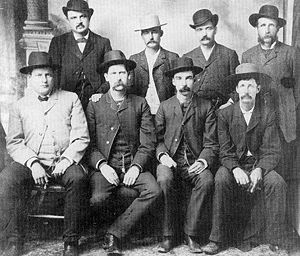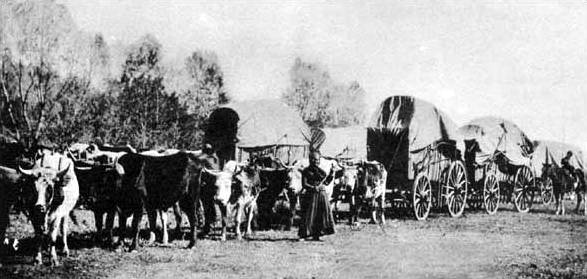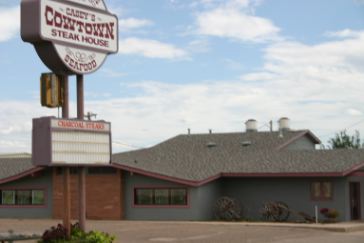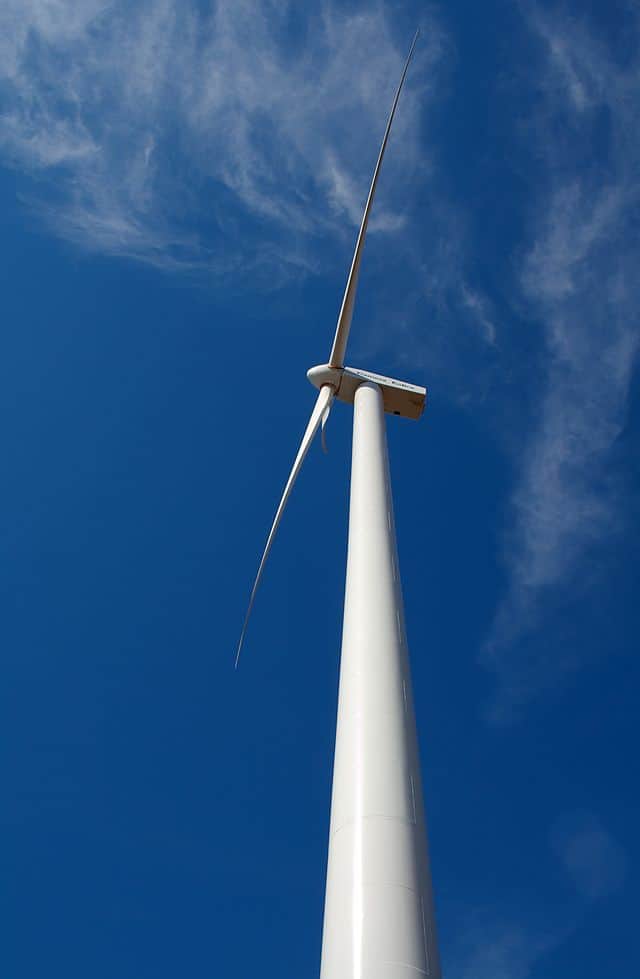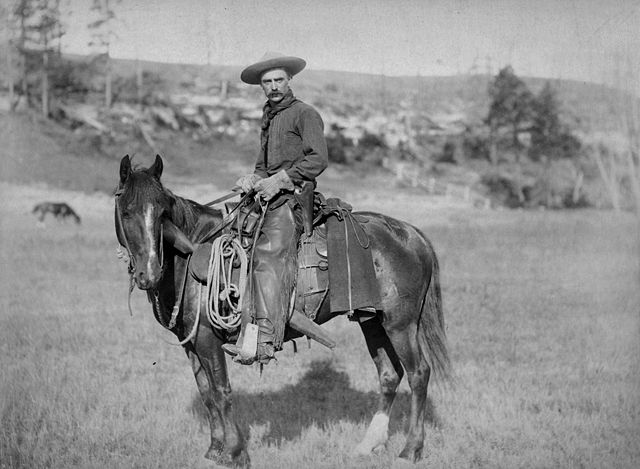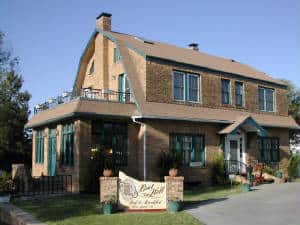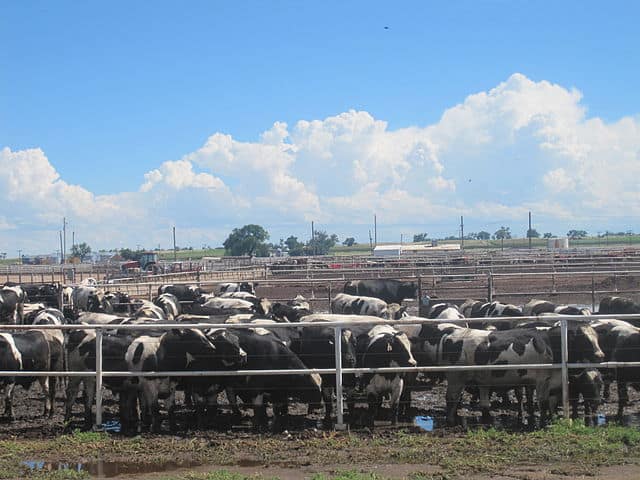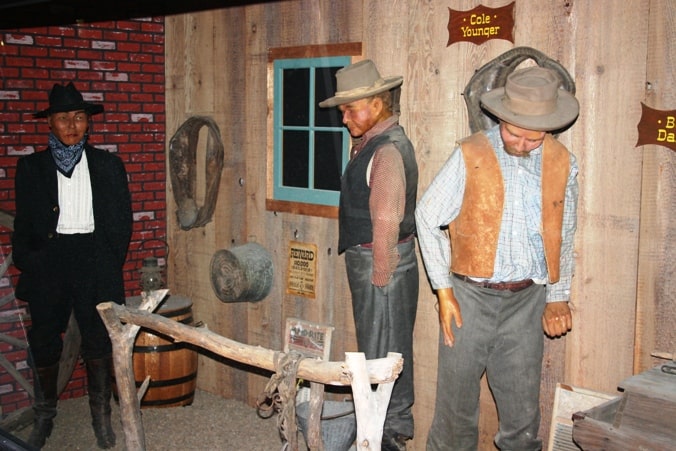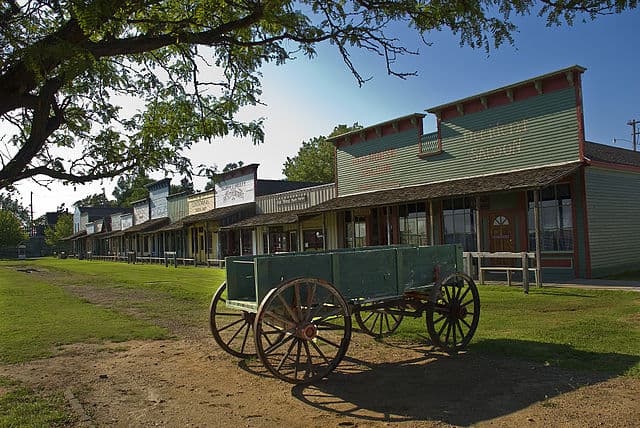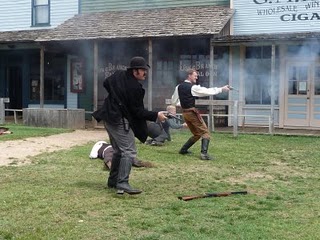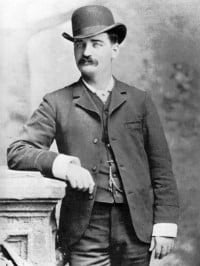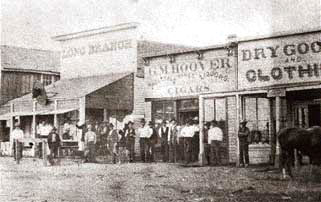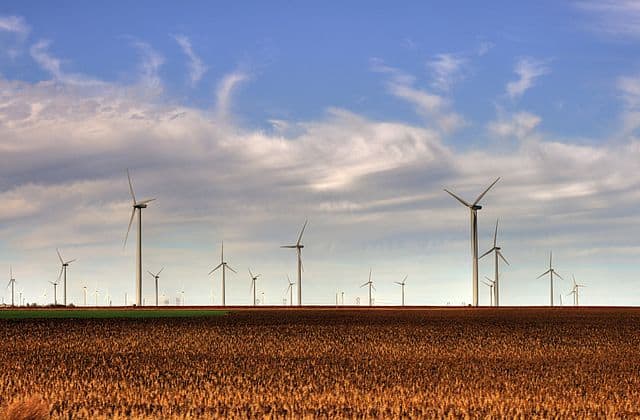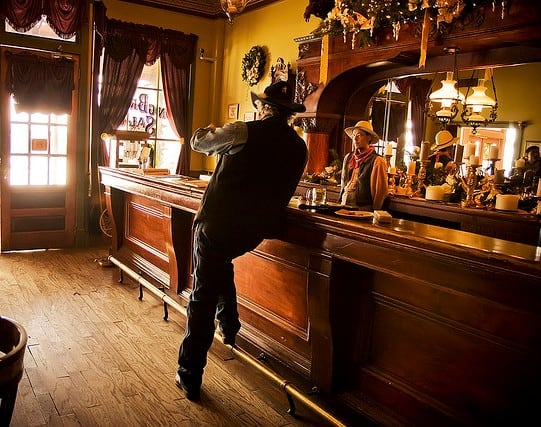
It had been my intention to grab a cold one at The Long Branch Saloon just like they had in those golden days of yesteryear.
The Old West was just the briefest snapshot in time. It’s odd to think that the era we consider the Rootin’ Tootin’ Wild West lasted all of about 15 years, existing during that brief period of time between the arrival of the first settlers and the effective establishment of law and order. Many television programs about the era have lasted longer. One of the most legendary towns of the Old West is Dodge City, Kansas. Located in the southwest corner of the state, Dodge City earned a reputation as “the wickedest town in the west” between 1872 and 1885.
The Santa Fe Trail Peters Out
On my way into town, I stopped to see the wagon tracks on the old Santa Fe Trail. In the days before cowboys and gunslingers, the trail went through here, transporting pioneers from Franklin, Missouri to Santa Fe de Nuevo, Mexico. For a brief time it was the road to the future, an avenue of progress. But then the railroad came and made it obsolete.
The trail is not much to see, a pair of ruts running through the grass, stretching off into the distance. The illusion of seeing it as the pioneers saw it is spoiled by the presence of tourists and by the distant outlines of gigantic wind turbines. If I was going to get a taste of the Old West, I was going to have to get it somewhere else. But I was pretty sure I had the right answer for that.
It was my intention to wind up the day with a cold one at the recreated Long Branch Saloon at the Boot Hill Museum in Dodge City. The Long Branch is famous in western lore for its outlaws and gunslingers, but the saloon, which is located inside the museum grounds, closes at 8pm, and I had arrived too late.
Instead, I found myself bellying up to the bar at Casey’s Cowtown Club, a low slung building inside a dusty parking lot, well regarded for its steaks and calf fries (otherwise known as Rocky Mountain oysters or cow testicles). I sidled up to the bar next to a brooding hulk of a man who was wearing a Stetson hat and gnawing on an unlit cigarillo. He turned to me, touched the brim of his hat and went back to watching TV.
He was watching a news story about landowners in the Flint Hills of Kansas protesting a wind farm development. He commented on it. He said, “It’s always someone.”
It was his opinion that anyone who kicked up a fuss about wind turbines wasn’t thinking straight. The ranchers got paid for allowing wind turbines on their land. What’s more, the power company was paying the county hundreds of thousands of dollars in lieu of taxes. Everybody benefited, and the towers didn’t disturb cattle or create a nuisance. Lots of folks even considered them sort of pretty.
“So who’s complaining?” I asked.
He sighed and looked down. “It’s always someone.”
Ill Winds A-Blowin’
Dodge City, Kansas was founded in 1872. It cropped up to take advantage of the railroad which was just then pushing west. Early on it became a cattle center when a cattle disease known as Texas Fever, carried by Longhorns driven up from Texas, began to spread into the local cattle population of the cowtowns further east. A quarantine line was established, banning Texas Longhorns from those eastern towns, so the Longhorns were driven to Dodge City where they could get easy access to the railhead and be shipped to Chicago for slaughter.
Naturally there were objections from local ranchers whose cattle were threatened by the disease, but the cattle driven from Texas via the Great Western Trail quickly became the life’s blood of Dodge City, making it “The Queen of Cowtowns”. The afflicted local ranchers were left to grumble and seethe.
The modern day ranchers objecting to the wind turbines seemed to be doing so largely for aesthetic reasons. They didn’t like the way the huge towers ruined the natural prairie scenery. They objected to the way transmission lines had been built across private property. Some even claimed the turbines altered wind flow patterns and frightened away wildlife. It was all a bunch of hooey in the opinion of my bar mate. But that didn’t stop the disgruntled ranchers from going to the legislature to seek a moratorium on the building of any more wind farms in the Flint Hills.
Something similar happened in Dodge City in the 1870’s. In the first years of its existence Dodge City boomed, growing fat and happy on the cowboy trade. Dusty cow pokes came into town seeking whiskey and women after many weeks on the trail. Dodge City seemed more than willing to accommodate.
Then in 1878, to the surprise of almost everyone, the city council passed a law outlawing gambling and prostitution. Practitioners of these vices were arrested. As it turned out, however, the law was not quite what it seemed.
Gun Play and Outlaws in Dodge City
Many of the men on Dodge City’s council had long benefited from the illicit trade in gambling and prostitution and disliked competition, so they arranged to have the new law selectively enforced, harassing their competition while turning a blind eye to those they favored. Naturally this caused resentment.

The city council was known collectively at the Dodge City Gang. That should tell you something about justice and the rule of law in Dodge City at the time.
To keep their “ordinance” going, those in power on the city council, known collectively as the Dodge City Gang, hired notorious gunfighters to enforce the law, among them Wyatt Earp and Bat Masterson, who became marshals of the rough and tumble county, enforcing what functioned effectively as a protection racket. Before long, the town became a hotbed of gun play and violence.
But that didn’t keep people from moving into the area. Newly arrived ranchers and farmers were appalled at the corruption and lawlessness and lent their voices to a growing chorus of objections about the unchecked spread of Texas Fever and the moral sinkhole Dodge City had become. They began to look around for somebody to help – anyone.
When progress collides with an entrenched culture, the result often makes for strange bedfellows. I left the hulking man at Casey’s Cowtown Club and made my way to the Boot Hill Bed & Breakfast where I spent the night in the Wyatt Earp Suite under a shimmery silver comforter beneath a wrought iron headboard and dreamed of gunplay and outlaws.
In the morning I was joined early at breakfast by a man and his family from Indiana. He was one of those middle-aged fellows with a narrow frame and a protuberant belly that jutted out over his waistline like a bottlenose dolphin at feeding time. His wife was quiet and docile, ever ready to withdraw at the first sign of conflict. The kids were freckle-faced and bashful, a boy and girl, nine and seven, who hung their heads and spoke meekly as if they were sitting in a church and not in the dining room of a pleasant B&B in the warm company of Kurt and Enid, our hosts, who were serving them breakfast.
The man and his family were headed to the Boot Hill Museum to see the staged gunfight and when I told them I was headed their myself, they insisted I join them. I tried to beg off, saying I was headed to the cattle feedlot first, but the patriarch of the family suddenly decided it would be instructional for the children to see some real cowboys before heading over to see the bogus version, so the next thing I knew we were all piled into their SUV headed to the feedlot.
A Real American
We stood on a hill overlooking more than a thousand head of cattle, many of them black and white Holsteins, all of them odoriferous. There was not a cowboy in site, not a lariat, not a spur, not a lonely harmonica song played beside a crackling campfire. It was then that I made the mistake of observing that cattle ranching wasn’t what it used to be.
Jeff launched into an speech about the sanctity of cherished American traditions as if cued by a director. He had a lot to say on the subject and was not timid about dragging in liberals and environmentalists and other blackhearted menaces who questioned core American values and threatened our way of life. I looked off into the distance, pretending disinterest and hoping to get away. His wife did pretty much the same. The kids had gone back to the car and were standing by the front bumper, holding their noses.
A Neat Trick in Dodge City
As we drove back into town, Jeff kept right on rolling. He didn’t like taxes and questioned the heritage of our former president. He loved Donald Trump and thought “Moslems” should be banned from the country, along with Mexicans and the other rapists and killers from south of the border. When he caught a glimpse of a wind turbine off in the distance, he decried the intrusion of these monstrosities on good honest ranchers by tree huggers and leftwing Nazis.
I mentioned that, to my understanding, many ranchers welcomed the turbines as they created jobs, reduced taxes and created an additional stream of income.
He was having none of it. Wind farms were a waste of money, he declared. They generated a tiny fraction of a percentage of energy nationwide, an amount out of all proportion to their prevalence. They interfered with aircraft. They killed birds. They were a particular danger to the American bald eagle, the symbol of our national sovereignty, having chopped many of them into ribbons.
It occurred to me that the wind farms had performed a neat trick. They had converted a conservative into a conservationist. He was all in favor of saving the bald eagles.
Things to do in Dodge City
Before heading to Boot Hill Museum, we stopped at the Gunfighter’s Wax Museum, located, oddly enough, inside the Kansas Teacher’s Hall of Fame. Here we viewed life-sized replicas of old west luminaries such as Calamity Jane, Doc Holliday and Festus, from the TV series Gunsmoke. It was an amateurish affair suffering from the usual mundane feeling one gets from underfunded wax museums and burdened by the slapdash nature of its execution. Our walk through it accelerated the closer we got to the end.
The Kansas Teacher’s Hall of Fame was similarly humdrum, consisting largely of placards and photos of exceptional educators who, presumably, would be the parties most interested in viewing these exhibits.
Finally we headed across the street to the Boothill Museum. If I had harbored any illusions that this would be authentic, they were dashed the minute we walked through the turnstile. The “town” consisted mostly of fake facades with a few original structures – a house, a school, a jail – salted in. Even the famous Boot Hill cemetery was just a replica, the actual bodies having been removed long ago.
Part hokey tourist trap and part earnest museum, Boothill fares better as a museum. It offers interesting exhibits on antique guns, Victorian fashion, the Plains Indians, and a multi-media presentation on the significance of the American buffalo to the region. I could have spent a little more time experiencing the rumbling of the floorboards (meant to simulate a buffalo stampede) but I was called away by the sound of gunfire in the street.
The twice daily gunfight was underway and tourists in flip-flops and bucket hats were gathering to watch the action. Third rate actors performed halfhearted stunts and fired blanks at each other in an effort to replicate what happened in Dodge City 125 years ago. What actually did happen was far more interesting.
Turning the Tables on Bat Masterson
The ranchers, angered by the unchecked spread of Texas fever and outraged by the violence and prostitution in town, made common cause with a saloon owner named Alonzo B. Webster and got him elected mayor. Webster’s election ousted Bat Masterson from power, and Webster went to work immediately cleaning up the town by issuing a series of ‘moral’ ordinances.
The problem was Webster was a saloon owner himself, and, far from wanting to curb drunkenness and prostitution, he stood to profit by it if he could only rid himself of the racket run by the Dodge City Gang and Bat Masterson. It was no surprise that his ordinances functioned pretty much the same way the Gang’s ordinances had, only in reverse. Now he and his crew were running the protection racket, and the Gang’s businesses were the targets. The tables had been turned.
In defiance a man named Luke Short, a friend of the Mastersons, bought a half interest in the Long Branch Saloon, the town’s most notorious saloon and brothel, and went right on conducting business as usual. In reply Webster had the saloon’s prostitutes placed under arrest.
Outraged, Short went to the jail to protest the matter, and a policeman named Louis C. Hartman confronted him. There was an exchange of gunfire and Short fled back to the Long Branch thinking he had killed Hartman. He holed up in the saloon, ready to fight to the death rather than submit to a hanging, but when he learned that Hartman was still alive he surrendered to the authorities and was banished from the town.
Short went immediately to Wyatt Earp and Bat Masterson and reported what had happened. The two gunfighters began to assemble a large force composed of ruthless gunslingers to retake the town. When Webster heard what was in the offing, he extended an olive branch, offering to allow Short to return to the Long Branch in exchange for peace. The gunfighters agreed.
The threat of bloodshed had been averted, but, having thrown in with the saloon owners, the ranchers had not gotten the reform they had wanted, and diseased Texas cattle continued to be driven to the railhead at Dodge City.
Finally in 1885 farmers settling in the region persuaded the state legislature to move the cattle quarantine line further west, effectively shutting down the cattle trade at Dodge. Virtually overnight the gambling, prostitution and corruption vanished. Not long after, the original Front Street buildings burned to the ground.
Fighting Against the Future
Back in the present day a posse of actors were doing their best to recreate the atmosphere. Jeff’s kids were fitted with sheriff’s badges, taken for a stagecoach ride, and treated to a chuck wagon dinner. Later in the evening there would be a can-can show at the recreated Long Branch Saloon, but I had seen enough. When Jeff and his family insisted I join them for an Old West photograph, I politely declined and made my way out of Dodge.
I never did order that cold one at the recreated Long Branch Saloon, which had been my original intention. Instead, I drove out of Dodge City with a six pack on the seat beside me.
I pulled over at a scenic overlook and sat on the brow of a hill overlooking the prairie as the sun began to set. As far as the eye could see the landscape was dotted with slowly turning wind turbines. There are more than a thousand wind turbines in Kansas today and more are planned. Kansas is ideally suited for wind power generation, and the incentives for ranchers and taxpayers are hard to dislike.
Those who do complain are a peculiar assortment of staunch conservatives making a conservationist argument and avowed liberals who don’t want their scenery interrupted. In any case, they seem to be fighting a losing battle. Like the Dodge City Gang that worked to maintain an atmosphere of vice and corruption in the face of a trend toward family oriented ranching and farming, the opponents of wind power seem desperate to maintain the past by standing in firm opposition to the future. But I suppose there’s nothing new about that.
Like the man in the Stetson said, “It’s always someone.”
Check it out…
Santa Fe Trail
9 miles west of Dodge City, KS
On US Hwy 50
Casey’s Cowtown Club
503 E Trail
Dodge City, KS 67801
(620) 227-5225
Boot Hill Bed & Breakfast
603 W Spruce St.
Dodge City, KS 67801
(620)-225-0111
Kansas Teacher’s Hall of Fame &
Gunfighter’s Wax Museum
603 Fifth Avenue
Dodge City, KS 67801
(620) 225-7311
Boot Hill Museum
Front Street
Dodge City, KS 67801
(620) 227-8188
Related Films and TV Shows:
Gunsmoke, James Arness plays Mat Dillon, marshal of Dodge City. The popular show ran for 20 seasons.
Dodge City, starring Errol Flynn who plays an honest marshal come to clean up Dodge.
Previous stop on the odyssey: Canon City, CO //
Next stop on the odyssey: Abilene, KS
Images Credits:
Long Branch Saloon Today, Saikofish; Wagon Train, Public Domain; Casey’s Cowtown Club, Travelks.com; Wind Turbine, Dori; Cowboy, Public Domain; Dodge City Gang, Enotes; Boothill Bed & Breakfast, Boothill B&B; Cattle Feedlot, Bill Hathorn; Gunfighter’s Wax Museum, Visitdodgecity.org; Boot Hill Museum, Public Domain; Boothill Museum Gunfight, TravelingLightblog; Long Branch Saloon, Lukeshort.info; Bat Masterson, Public Domain; Kansas Wind Farm, Drenaline

